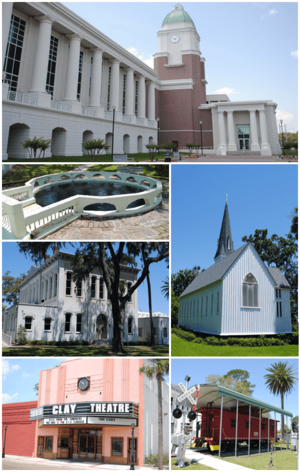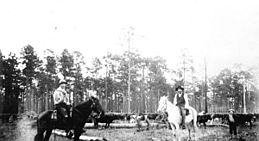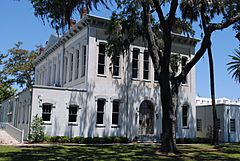Green Cove Springs, Florida facts for kids
Quick facts for kids
Green Cove Springs, Florida
|
|
|---|---|
| City of Green Cove Springs | |

Images from top, left to right: Clay County Courthouse, the springs, Clay County Courthouse, St. Mary's Episcopal Church, Clay Theatre, Clay County Historical Museum
|
|

Location in Clay County and the state of Florida
|
|
| Country | United States of America |
| State | Florida |
| County | Clay |
| Settled | 1816 |
| Incorporated | November 2, 1874 |
| Government | |
| • Type | Council-Manager |
| Area | |
| • Total | 10.27 sq mi (26.59 km2) |
| • Land | 7.53 sq mi (19.50 km2) |
| • Water | 2.74 sq mi (7.09 km2) |
| Elevation | 16 ft (5 m) |
| Population
(2023)
|
|
| • Total | 10,130 |
| • Density | 1,345.29/sq mi (519.49/km2) |
| Time zone | UTC-5 (Eastern (EST)) |
| • Summer (DST) | UTC-4 (EDT) |
| ZIP code |
32043
|
| Area code(s) | 904, 324 |
| FIPS code | 12-27400 |
| GNIS feature ID | 0283381 |
Green Cove Springs is a city in and the county seat of Clay County, Florida, United States. Green Cove Springs is a part of the Jacksonville, Florida Metropolitan Statistical Area. The population was 9,786 at the 2020 census, up from 6,908 at the 2010 census.
The city is named after the portion of the St. Johns River upon which it is built. The river bends here, and the area is sheltered by trees that are perennially green.
Contents
History
The area was first inhabited over 7,000 years ago by Native Americans attracted to a warm mineral spring. The hydrological spring, locally known as the "Original Fountain of Youth", attracted patrons in the 19th century to the spa town, where more than a dozen hotels were built near the spring to accommodate them. Today, the sulfur-scented spring water feeds an adjacent public swimming pool before flowing the short distance to the St. Johns River. The Green Cove Springs area was first developed by George J. F. Clarke in 1816 when he was provided land, under a Spanish land grant, to build a sawmill. Green Cove Springs was established in 1854 as White Sulfur Springs. Renamed in 1866, it became the Clay County seat in 1871.
Agriculture and tourism were the two primary economic activities in the area until the end of the 19th century, when Henry Flagler's railroad began taking tourists further south in Florida. In 1895, the Great Freeze destroyed the area's citrus crops, and tourism all but ended. The 1920s had renewed development, with automobile traffic once again bringing in tourists. The Great Depression of the 1930s marked the end of this period of growth for the city.
The first women's club in the state of Florida was established in Green Cove Springs in 1883. The Village Improvement Association led local efforts to beautify the town, and established its first public library.
The period immediately before and during World War II again brought new growth to Green Cove Springs. On September 11, 1940, the U.S. Navy opened Naval Air Station Lee Field in honor of Ensign Bejamin Lee, who had lost his life in a crash at Killinghome, England, during World War I. In August 1943, the facility was renamed Naval Air Station Green Cove Springs and consisted of four 5,000-foot (1,500 m) asphalt runways. One of the Marine Corps aviators training in the F4U Corsair Operational Training Unit at Lee Field in early 1945 was eventual television personality Ed McMahon. After the war, NAS Green Cove Springs was downgraded in status to a Naval Auxiliary Air Station (NAAS) as part of the greater NAS Jacksonville complex. Thirteen piers were constructed along the west bank of the St. Johns River adjacent to NAAS Green Cove Springs to house a U.S. Navy Atlantic Reserve Fleet, Florida "mothball fleet" of some 500 vessels, primarily destroyers, destroyer escorts, and fleet auxiliaries. In 1960, the Navy decommissioned NAAS Green Cove Springs and the pier facility. Some of the mothballed vessels were transferred to foreign navies, while others were relocated to other Reserve Fleet locations.
In 1984, the city annexed the former naval base into the city to use it for further growth and development as the Clay County Port and Reynolds Industrial Park. The air station is now a private airfield known as Reynolds Airpark (FAA airfield identifier FL60) with a single 5,000-foot (1,500 m) asphalt runway currently operational, although reportedly in poor condition. Though the original air traffic control tower is still standing, attached to one of the former Navy aircraft hangars, the airfield remains an uncontrolled facility.
Green Cove Springs is the birthplace of Charles E. Merrill (1885–1956), one of the founders of Merrill Lynch. The town's spring is described by his son James Merrill in the poem "Two From Florida", published in The Inner Room (1988).
Green Cove Springs is also the birthplace of Augusta Savage (née Augusta Christine Fells, February 29, 1892 – March 26, 1962). Savage was an African-American sculptor associated with the Harlem Renaissance.
Locally, the community is known as the home of Gustafson's Farm, a brand name of milk and dairy products sold throughout Florida. The main Gustafson Dairy Farm is located in Green Cove Springs and is one of the largest privately owned dairy farms in the Southeastern United States. Started in 1908, the main farm occupies nearly 10,000 acres (40 km2) adjacent to the city limits. Gustafson's has many bottling plants across the state, stretching from Tallahassee in the west to Tampa and Cocoa in the south. All Gustafson products have the picture of the husband-and-wife founders, Frank and Agnes Gustafson (also known as Mama and Papa Gus), who along with their first cow on their farm (named "Buttercup") are prominently featured on the packaging of the dairy's products.
Scenes for the 1971 "B" monster movie Blood Waters of Dr. Z (or Zaat) were filmed here. The movie was satirized on the television program Mystery Science Theater 3000.
Historic places
These sites are listed on the National Register of Historic Places:
- Clay County Courthouse
- Green Cove Springs Historic District
- St. Mary's Church
- “The Hellhouse” original rehearsal studio to Lynyrd Skynyrd
Geography
Green Cove Springs is located on the eastern border of Clay County at 29°59′34″N 81°41′2″W / 29.99278°N 81.68389°W (29.992716, –81.683786), along the St. Johns River.
U.S. Route 17 passes through the center of town as Orange Avenue and leads north 28 miles (45 km) to downtown Jacksonville and south 26 miles (42 km) to Palatka. State Road 16 departs west from the center of the city and leads 27 miles (43 km) to Starke. SR 16 leaves eastbound from US 17 south of the city center and crosses the St. Johns River by the Shands Bridge, leading to St. Augustine 25 miles (40 km) to the east. By the late 2020s, the First Coast Expressway, a major toll bypass road connecting I-10 and I-95, is expected to pass to the west and south of Green Cove Springs.
According to the United States Census Bureau, the city has a total area of 9.9 square miles (25.6 km2), of which 7.4 square miles (19.1 km2) are land and 2.5 square miles (6.5 km2), or 25.35%, are covered by water.
Demographics
| Historical population | |||
|---|---|---|---|
| Census | Pop. | %± | |
| 1880 | 320 | — | |
| 1890 | 1,106 | 245.6% | |
| 1900 | 929 | −16.0% | |
| 1910 | 1,319 | 42.0% | |
| 1920 | 2,093 | 58.7% | |
| 1930 | 1,719 | −17.9% | |
| 1940 | 1,752 | 1.9% | |
| 1950 | 3,291 | 87.8% | |
| 1960 | 4,233 | 28.6% | |
| 1970 | 3,857 | −8.9% | |
| 1980 | 4,154 | 7.7% | |
| 1990 | 4,497 | 8.3% | |
| 2000 | 5,378 | 19.6% | |
| 2010 | 6,908 | 28.4% | |
| 2020 | 9,786 | 41.7% | |
| 2023 (est.) | 10,130 | 46.6% | |
| U.S. Decennial Census | |||
2010 and 2020 census
| Race | Pop 2010 | Pop 2020 | % 2010 | % 2020 |
|---|---|---|---|---|
| White (NH) | 4,920 | 6,862 | 71.22% | 70.12% |
| Black or African American (NH) | 1,291 | 1,275 | 18.69% | 13.03% |
| Native American or Alaska Native (NH) | 19 | 26 | 0.28% | 0.27% |
| Asian (NH) | 66 | 153 | 0.96% | 1.56% |
| Pacific Islander or Native Hawaiian (NH) | 12 | 25 | 0.17% | 0.26% |
| Some other race (NH) | 4 | 42 | 0.06% | 0.43% |
| Two or more races/Multiracial (NH) | 113 | 427 | 1.64% | 4.36% |
| Hispanic or Latino (any race) | 483 | 976 | 6.99% | 9.97% |
| Total | 6,908 | 9,786 |
As of the 2020 United States census, there were 9,786 people, 2,997 households, and 2,046 families residing in the city.
As of the 2010 United States census, there were 6,908 people, 2,379 households, and 1,737 families residing in the city.
Religion
Catholic
Sacred Heart Catholic Church, part of the Diocese of St. Augustine, was founded as a mission back in 1874, and now serves the city.
Protestant
The oldest protestant church in Green Cove Springs is Hickory Grove Baptist Church. Other Baptist churches include First Baptist, First African Missionary Baptist and Mount Pleasent Missionary Baptist.
St. Mary's is the main Episcopal Church in Green Cove Springs.
United Methodist Church and Mount Zion African Methodist are the two methodist churches.
The CCUS has a Congregationalist church in both Green Cove and Penney Farms.
Education
Green Cove Springs is part of the Clay County School District. The city is home to Charles E. Bennett Elementary School, Green Cove Springs Jr. High School, and the Bannerman Learning Center. Clay High School lies just feet outside of the western city limits.
Notable people
- Kevin Allen (born 1965), racing driver
- Cliff Avril (born 1986), player in the National Football League
- Charles Thomas Butler (1906–1964), Major League Baseball pitcher
- Frank J. Canova Jr. (born 1956), electronics engineer, known for inventing the smartphone
- Caeleb Dressel (born 1996), swimmer and seven-time Olympic gold medalist
- Will Holden (born 1993), player in the National Football League
- Charles E. Merrill (1885–1956), American businessman and philanthropist
- Maxey Dell Moody Jr. (1913–1987), founder of MOBRO Marine, Inc.
- Augusta Fells Savage (1892–1962), sculptor and art educator, leader during the Harlem Renaissance of the 1920s
Museums
- Clay County Historical Society Museum
- Military Museum of North Florida
Transportation
Roadways
 SR 16 East - Leonard C. Taylor Parkway
SR 16 East - Leonard C. Taylor Parkway SR 16 West - Idlewild Avenue / Ferris Street
SR 16 West - Idlewild Avenue / Ferris Street US 17 - (North/South) Orange Avenue
US 17 - (North/South) Orange Avenue
The city center lies at the crossroads of US 17 and Florida 16. Just outside the city on Florida 16 East is Shands Bridge, a long and narrow two-lane bridge across the St. Johns River connecting the city and the rest of Clay County to St. Johns County.
JTA Clay Community Transportation
The main transit system for Green Cove Springs is serviced by Clay Community Transportation (CCT), a regional service under the Jacksonville Transit Authority (JTA). CCT services two lines that run through Green Cove Springs:
- Clay Blue Line - connecting Green Cove Springs to Penney Farms, Fleming Island, Lakeside, Orange Park and Naval Air Station Jacksonville
- Clay Green Line - connecting Green Cove Springs to Doctor's Inlet, Fleming Island, Penney Farms and Keystone Heights.
Rail
While not a stop for any rail services, a rail line runs right through the middle of the city.
Airports
Green Cove Springs has two airports:
- Reynold Airpark (formerly Naval Auxiliary Air Station Lee Field) - a discontinued and condemned naval air strip now privately owned.
- Haller Airpark - a small private airstrip actively used for local and personal aviation.
See also
 In Spanish: Green Cove Springs para niños
In Spanish: Green Cove Springs para niños





